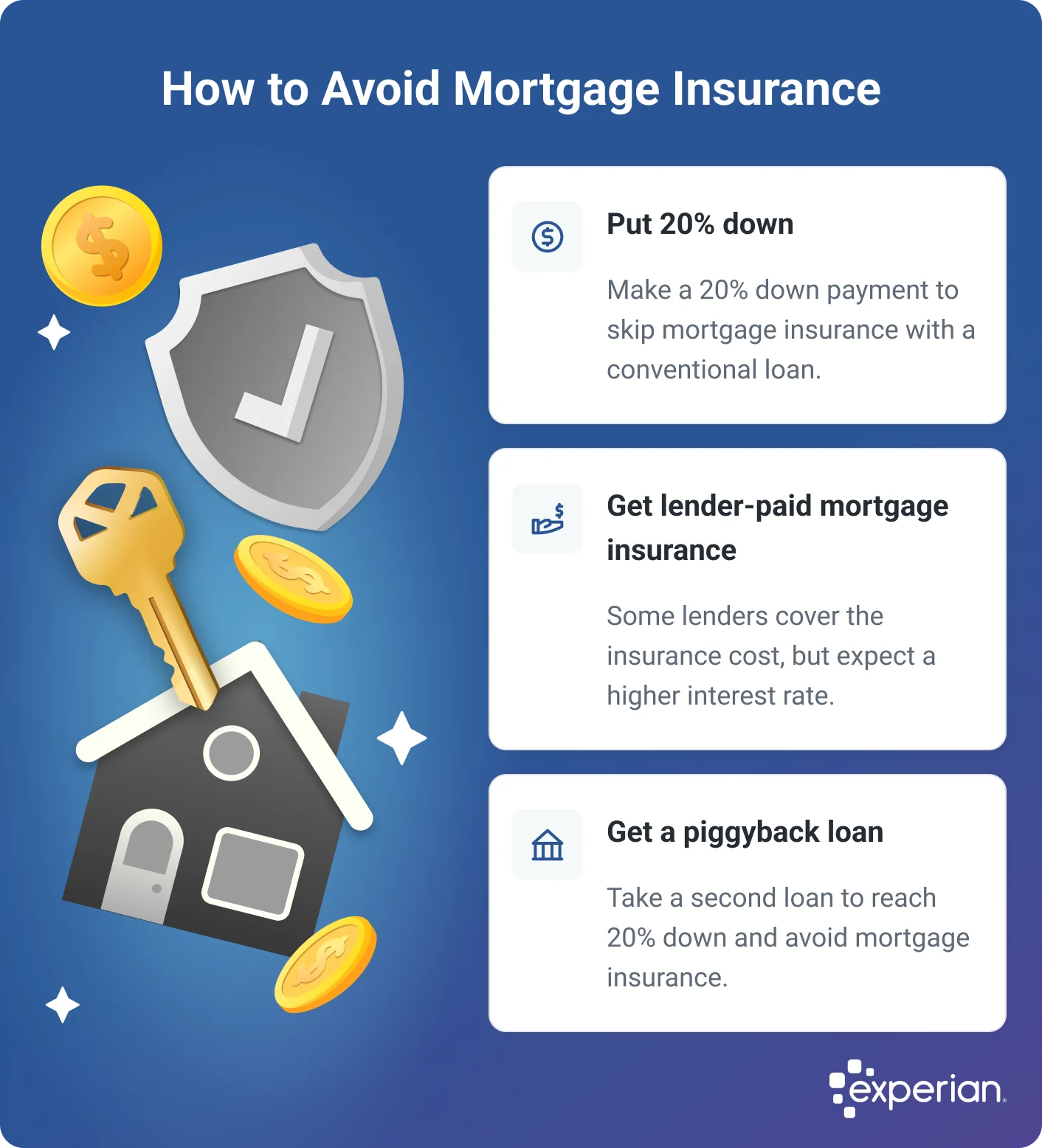What Is Mortgage Insurance?
Quick Answer
Mortgage insurance helps protect lenders from borrowers who don’t make their mortgage payments. You may have to pay the premiums if you have a small down payment or get a government-backed mortgage, but you can also look for ways to avoid (or get rid of) the insurance premiums.

Mortgage insurance helps protect lenders from losses if borrowers stop making mortgage payments. You may be required to purchase mortgage insurance or similar types of coverage if you get certain government-backed mortgages or a conventional mortgage with less than a 20% down payment. Additionally, you'll likely want (and may be required to buy) homeowners insurance, which protects you if something happens to your home.
What Is Mortgage Insurance?
Mortgage insurance policies limit lenders' risk, which is why it's easier to qualify for a mortgage with mortgage insurance. In general, homebuyers who pay for mortgage insurance tend to have lower credit scores and higher loan-to-value (LTV) and debt-to-income (DTI) ratios than borrowers who get conventional mortgages without insurance. They also tend to be first-time homebuyers.
Who Does Mortgage Insurance Protect?
Mortgage insurance policies protect the lender, rather than you, the borrower. That said, you'll have to pay the premiums. There might be an upfront insurance cost that's added to your other closing costs or rolled into the mortgage. Plus, you'll pay a monthly fee that will be part of your monthly mortgage payments.
Learn more: Do I Need Mortgage Insurance?
Compare mortgage rates
Check today’s rates to find the best loan offers. Staying updated on current rates helps you secure a competitive mortgage and save more over time.
Types of Mortgage Insurance
There are several types of mortgage insurance and similar insurance-like programs that vary depending on the type of mortgage. Here's an overview of how each works.
Private Mortgage Insurance (PMI)
Generally, you have to pay for mortgage insurance if you get a conventional mortgage (non-government-backed mortgage) and put less than 20% down. For example, with a $400,000 mortgage, you may have to pay for mortgage insurance if your down payment is less than $80,000.
On conventional loans, mortgage insurance is called private mortgage insurance (PMI), and borrowers often pay the monthly premiums as part of their mortgage payments. However, you may be able to alternatively make a single upfront payment, or split the cost between upfront and monthly payments.
FHA Mortgage Insurance
Federal Housing Administration (FHA) mortgages are backed by the FHA and offered by certain lenders. There are several types of FHA loans, and these could be a good option if you have only a small down payment or don't have good enough credit to qualify for conventional loans. FHA loans have a mortgage insurance premium (MIP) that you'll pay for with an upfront fee and monthly payments.
USDA Guarantee Fees
U.S. Department of Agriculture (USDA) home loans don't require down payments and can help buyers who have low income or credit purchase a home in certain suburban and rural areas. USDA loans don't technically have mortgage insurance, but you have to pay upfront and annual guarantee fees that essentially serve the same purpose. You can roll the upfront portion into your mortgage if you'd prefer.
VA Loan Funding Fees
U.S. Department of Veterans Affairs (VA) home loans don't require a down payment and don't have mortgage insurance. However, you may have to pay a one-time funding fee, which you can choose to roll into your mortgage. Some people may qualify for a fee waiver or refund—the VA's website lists the requirements.
Pros and Cons of Mortgage Insurance
Mortgage insurance provides a clear benefit to your lender, because it protects them from financial losses in the event that a borrower defaults. But the benefits and drawbacks may be less clear for the borrower. Here's a rundown.
Pros of Mortgage Insurance
-
You can buy a home with less money down. If you don't have enough savings for a 20% down payment, you might qualify for a conventional mortgage with a smaller down payment and mortgage insurance.
-
It gives you more options. You may be able to choose from a wider range of homes if you consider different combinations of mortgage types, mortgage amounts and insurance requirements.
-
PMI gets automatically removed. A conventional mortgage's PMI will be automatically removed when your mortgage's principal balance is scheduled to be 78% of your home's original value—and you can request to have your PMI removed earlier.
Cons of Mortgage Insurance
-
It requires higher upfront costs. You may have to pay for part of the insurance upfront, which can increase your closing costs. However, you may also be able to add these upfront fees to your mortgage rather than paying for them with cash.
-
You'll have higher monthly payments. The monthly mortgage insurance premium can also increase your monthly housing costs.
-
It could stick for the life of the loan. With government-backed loans, you'll have to refinance if you want to get rid of the mortgage insurance payments.
How Much Does Mortgage Insurance Cost?
Your mortgage insurance costs will depend on the type of mortgage you get and your loan amount. With each type of mortgage, the rates can also vary based on eligibility and other factors.
- Conventional loan PMI: PMI costs anywhere from 0.2% to 2% of the total loan amount per year when borrowers make monthly payments. Your rate is based on several factors, such as your credit score, down payment and length of the loan.
- FHA loan MIP: The upfront portion of your mortgage insurance premium is usually 1.75% of the loan amount—your credit score doesn't impact your premiums—and you can add the fee to your mortgage rather than paying it in cash if you'd prefer. The monthly payments are based on the annual premium, which is 0.15% to 0.5% of the loan amount.
- USDA guarantee fees: The USDA upfront guarantee fee is 1% of the loan amount, which you can add to your mortgage balance. The annual fee, which you'll pay for monthly, is 0.35% of the loan amount.
- VA funding fees: The VA funding fee ranges from 0.5% to 3.3% depending on the type of VA loan, whether you're buying a home or refinancing your mortgage, and whether this is the first time you get a VA loan.
How Do I Reduce the Cost of Mortgage Insurance?
If you can't afford or qualify for a conventional loan with a 20% down payment, you might have to pay for mortgage insurance or similar fees. However, figuring out which option is best can be complicated and you may want to work with an experienced mortgage broker or loan officer who can help you compare options.
You can use a mortgage calculator to see how different choices could impact your upfront and monthly costs. But other factors, such as how long you plan on living in the home and whether you might refinance in the next few years, can also be important to consider.
Learn more: Ways to Save Money on Your Mortgage
How to Avoid Mortgage Insurance
There are several ways to buy a home without paying for mortgage insurance. However, they might not be realistic for you right now, and they aren't necessarily better than putting less money down or getting a government-backed mortgage and paying for mortgage insurance.
- Put 20% down. If you can afford to make at least a 20% down payment, the most straightforward option is to get a conventional loan.
- Get lender-paid mortgage insurance. Some mortgage lenders offer conventional loans that don't require a 20% down payment or mortgage insurance. However, you'll often receive a higher interest rate because the lender is paying for the insurance.
- Get a piggyback loan. You might be able to get a piggyback loan or 80-10-10 mortgage, essentially taking out a second mortgage and using the funds to make a 20% down payment on the first mortgage. Although you'll avoid mortgage insurance, you'll have to qualify and pay closing costs for both loans, accrue more interest payments and potentially face more complicated refinancing down the road.

How Do I Get Rid of Mortgage Insurance?
You may be able to get rid of PMI once your mortgage's principal value is 80% of your home's original value—in other words, you have 20% equity in the home. That might mean you're only paying for PMI for a handful of years. However, if you opt for lender-paid mortgage insurance, you might be stuck with the higher interest rate until you refinance your loan—and that may only be a good option if rates drop.
An FHA loan's MIP generally stays for the lifetime of the loan, which means you may need to refinance if you want to get rid of your mortgage insurance. However, if you put more than 10% down for an FHA loan with at least a 15-year term, the MIP only lasts 11 years.
Tip: As with comparing the different types of loans and insurance payments, you'll want to carefully review all of the realistic options to figure out which one will be best based on your finances and plan for the home.
Learn more: How to Lower Monthly Mortgage Payments
Frequently Asked Questions
Check and Monitor Your Credit
Although your credit score will only impact your mortgage insurance rates with a conventional loan, your credit history and scores can affect your eligibility for different types of mortgages and the interest rate you receive. If you're getting ready to buy a home, check your credit report and a FICO® ScoreΘ to see where you're at.
Curious about your mortgage options?
Explore personalized solutions from multiple lenders and make informed decisions about your home financing. Leverage expert advice to see if you can save thousands of dollars.
Learn moreAbout the author
Louis DeNicola is freelance personal finance and credit writer who works with Fortune 500 financial services firms, FinTech startups, and non-profits to teach people about money and credit. His clients include BlueVine, Discover, LendingTree, Money Management International, U.S News and Wirecutter.
Read more from Louis